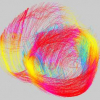Free Online Productivity Tools
i2Speak
i2Symbol
i2OCR
iTex2Img
iWeb2Print
iWeb2Shot
i2Type
iPdf2Split
iPdf2Merge
i2Bopomofo
i2Arabic
i2Style
i2Image
i2PDF
iLatex2Rtf
Sci2ools
89
Voted
ISBI
2006
IEEE
2006
IEEE
Estimating myocardial fiber orientations by template warping
Myocardial fiber orientations are an important element for accurate modeling of cardiac electromechanics. However it is extremely difficult to estimate these directly in vivo with current imaging techniques. Most current methods for cardiac modeling use synthetic models of fiber orientation which may fail to capture subtle variations of fiber orientations in different hearts. We present a method to map the fiber orientations obtained from diffusion tensors from a template onto patientspecific cardiac geometry, using elastic registration followed by a reorientation of the diffusion tensors based on the local rotation component of the transformation. The effectiveness of the diffusion tensor mapping is validated on a set of diffusion tensor imaging datasets obtained from 19 canine subjects. The algorithm was able to map the diffusion tensors effectively for both healthy and failing hearts.
Diffusion Tensor Mapping | Diffusion Tensors | ISBI 2006 | Medical Imaging | Myocardial Fiber Orientations |
Related Content
| Added | 20 Nov 2009 |
| Updated | 20 Nov 2009 |
| Type | Conference |
| Year | 2006 |
| Where | ISBI |
| Authors | Hari Sundar, Dinggang Shen, George Biros, Harold Litt, Christos Davatzikos |
Comments (0)

